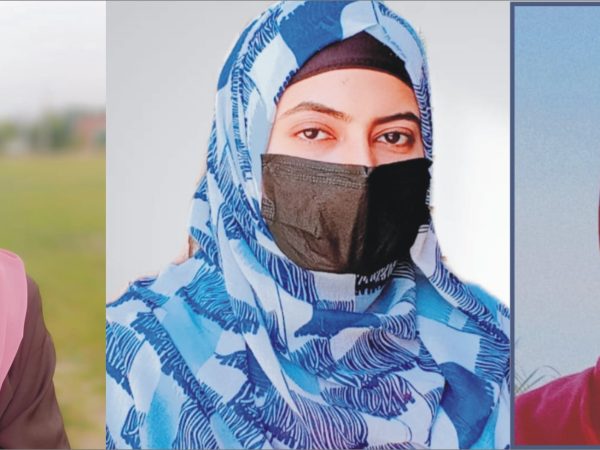MONONUCLEOSIS DISEASE AND ITS MODE OF TRANSMISSION

HISTORY OF MONONUCLEOSIS:
Mononucleosis, also known as “mono,” has a fascinating history. The disease was first described in the early 20th century. mononucleosis has a rich history that spans centuries . The Epstein-Barr virus (EBV), which is responsible for causing mononucleosis, was discovered in 1964 by
Dr. Michael Anthony Epstein and Dr. Yvonne Barr. They identified the virus in cells taken from a patient with Burkitt’s lymphoma, a type of cancer commonly found in Africa. This breakthrough led to a better understanding of the virus and its association with mononucleosis.
The disease gained the nickname “the kissing disease” due to its association with close contact, such as kissing or sharing utensils. This is because the virus is primarily transmitted through saliva. It can also be spread through coughing, sneezing, or contact with contaminated surfaces.
Over the years, researchers have made significant progress in understanding the virus and developing diagnostic tests. Today, healthcare professionals can accurately diagnose mononucleosis through physical examinations and laboratory tests that detect specific antibodies or an increased number of white blood cells.
ABSTRACT:
Mononucleosis is a contagious infection caused by a herpes virus called Epstein-Barr. Other viruses can also cause mono. The infection is common among teenagers and young adults. People with mono experience extreme fatigue, fever and body aches.it primarily affects teenagers and young adults, causing symptoms like extreme fatigue, sore throat, swollen lymph nodes and fever. Mononucleosis (mono) is a viral infection that cause a sore throat and fever. Cases often happen in teens and young adults. It goes away on its own after a few weeks of rest.
In this article, we’ll explore the mode of transmission, the virus itself,the sign and symptoms, diagnosis, treatment options, the historical background of the disease and conclude with some important take a ways.
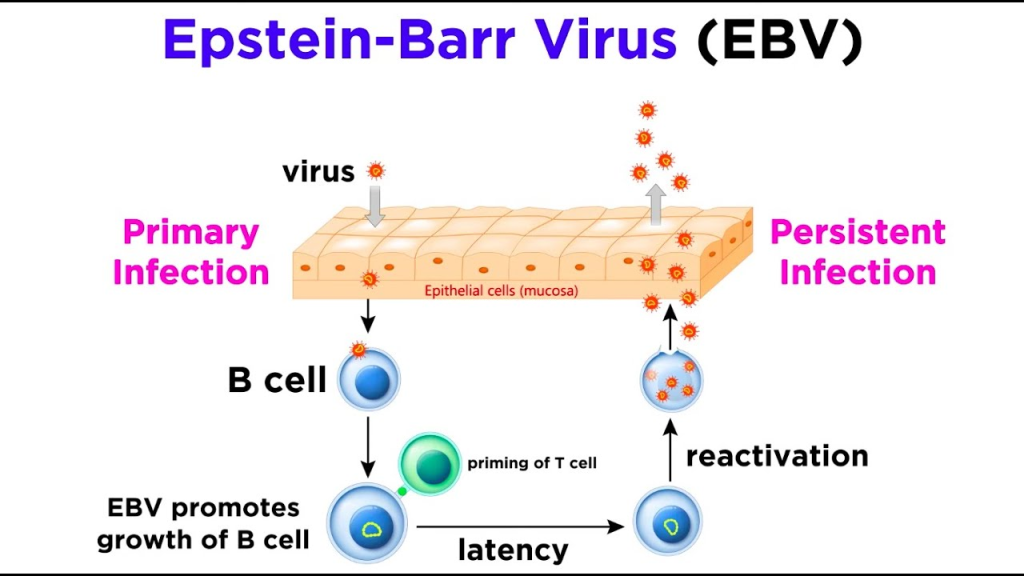
Infectious mononucleosis is caused by the Epstein-Barr virus (EBV). EBV can spread through contact with saliva from an infected person, for example you can get it through kissing, sharing eating utensils with, or drinking from the same glass as someone who infected with the virus
Introduction:
Mononucleosis is a widespread viral infection that affects people worldwide. It is often transmitted through saliva, hence its association with kissing and sharing of drinks or utensils. Let’s delve deeper into the different aspects of this disease.
It is estimated that over 90% of Americans will get infected with the virus that causes mono by the time they are 35 years old. Most people who are infected with EBV don’t actually develop mono.
Mode of Transmission:
Mononucleosis is primarily spread through close contact with an infected person’s saliva. This can occur through activities like kissing, sharing utensils, or even coughing and sneezing. The virus can also survive on surfaces for a short period, making indirect transmission possible.
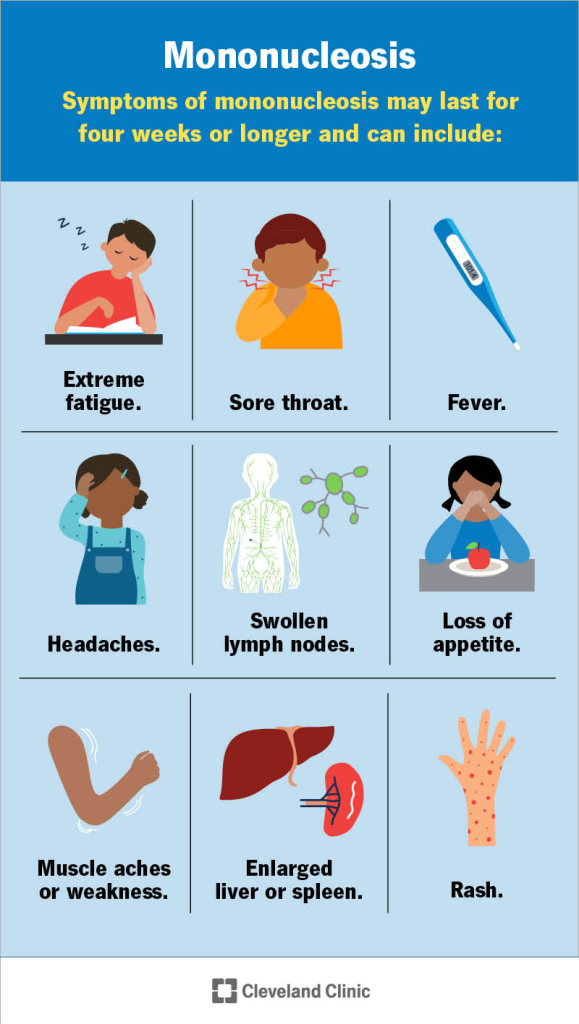

Virus:
The Epstein-Barr virus (EBV) is the main culprit behind mononucleosis. It belongs to the herpes virus family and is highly contagious. Once the virus enters the body, it invades and replicates in the cells of the throat and immune system.

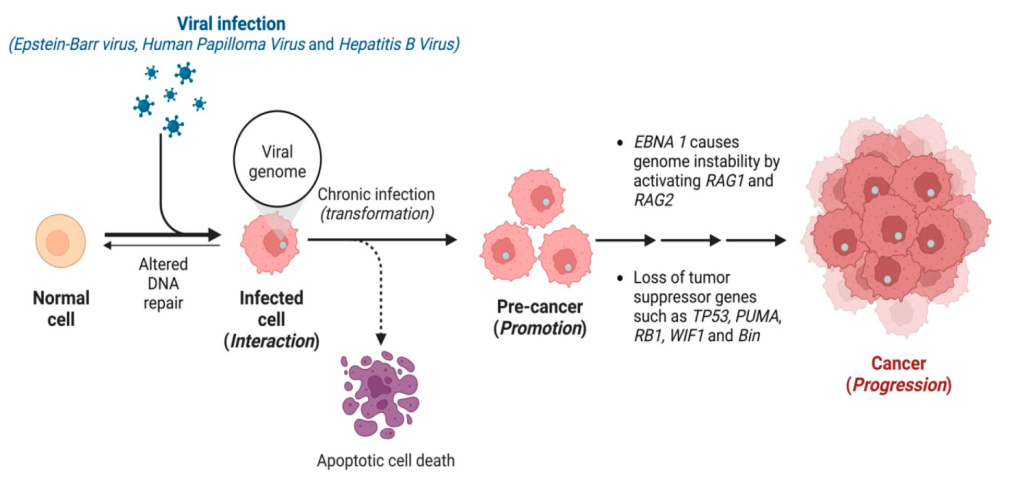
Signs and Symptoms:
The most common symptoms of mononucleosis include severe fatigue, sore throat, swollen lymph nodes, fever, and body aches. Some individuals may also experience a rash, enlarged spleen, or liver problems. These symptoms can last for several weeks or even months. Signs and symptoms of mononucleosis may include:
- Fatigue
- Sore throat, perhaps misdiagnosed as strep throat, that doesn’t get better after treatment with antibiotics
- Fever
- Swollen lymph nodes in your neck and armpits
- Swollen tonsils
- Headache
- Skin rash
- Soft, swollen spleen
The virus has an incubation period of about four to six weeks, although in young children this period may be shorter. The incubation period refers to how long before your symptoms appear after being exposed to the virus. Signs and symptoms such as a fever and sore throat usually lessen within a couple of weeks. But fatigue, enlarged lymph nodes and a swollen spleen may last for a few weeks longer.

Diagnosis:
Diagnosing mononucleosis involves a combination of physical examination, medical history review, and laboratory tests. A healthcare professional may examine the throat, check for swollen lymph nodes, and order blood tests to detect the presence of specific antibodies or an increased number of white blood cells.

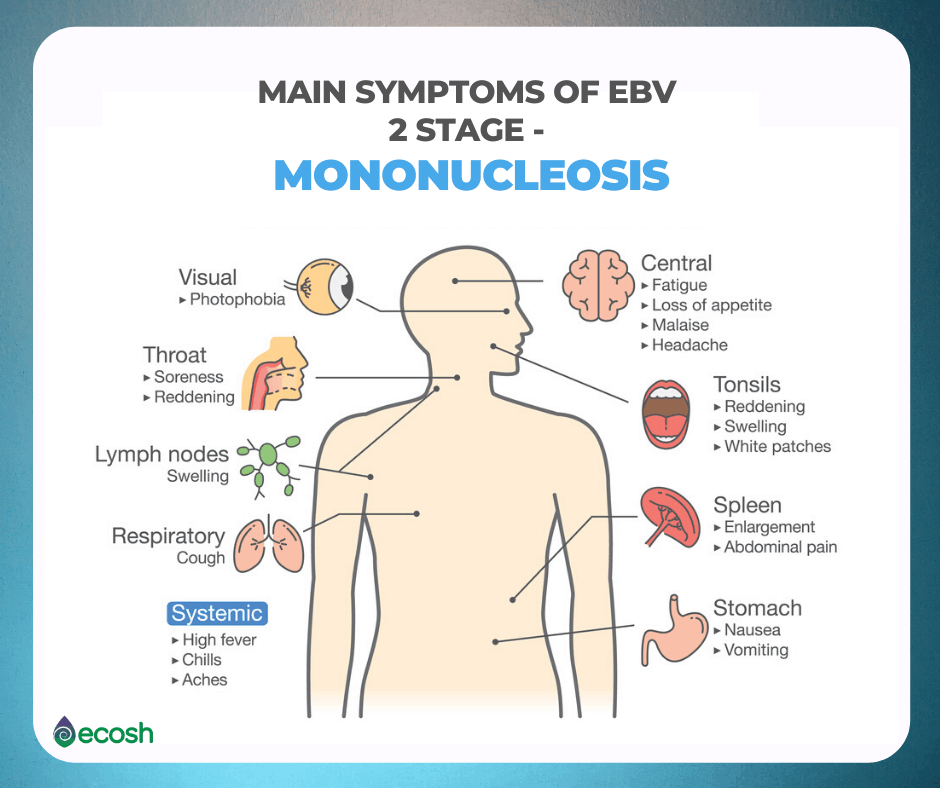
Causes:
The most common cause of mononucleosis is the Epstein-Barr virus, but other viruses also can cause similar symptoms. This virus is spread through saliva, and you may catch it from kissing or from sharing food or drinks.
Although the symptoms of mononucleosis are uncomfortable, the infection resolves on its own without long-term effects. Most adults have been exposed to the Epstein-Barr virus and have built up antibodies. This means they’re immune and won’t get mononucleosis.
Treatment:
There is no specific cure for mononucleosis, so treatment mainly focuses on managing the symptoms and promoting recovery. Rest, staying hydrated, and taking over-the-counter pain relievers can help alleviate discomfort. It’s important to avoid activities that could strain the spleen, as it may become enlarged during the infection.
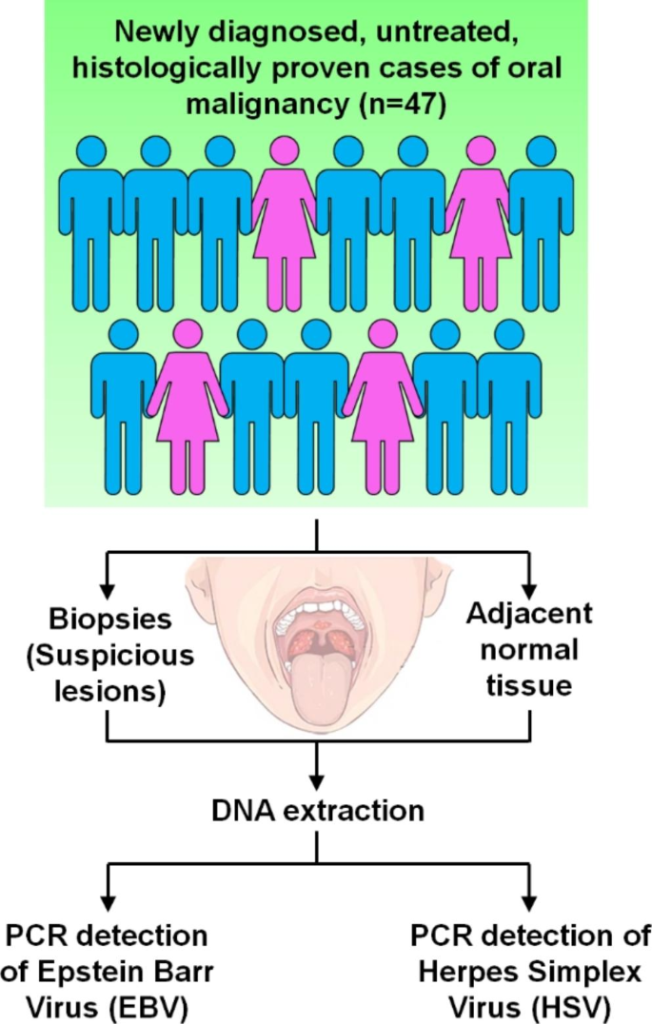
Complications
Complications of mononucleosis can sometimes be serious.
Enlargement of the spleen
Mononucleosis may cause enlargement of the spleen. In extreme cases, your spleen may rupture, causing sharp, sudden pain in the left side of your upper abdomen. If such pain occurs, seek medical attention immediately — you may need surgery.
Enlarged spleen
The spleen is a small organ usually about the size of your fist. But a number of conditions, including liver disease and some cancers, can cause your spleen to become enlarged.
Liver issues
Problems with your liver also may occur:
- You may experience mild liver inflammation (hepatitis).
- A yellowing of your skin and the whites of your eyes (jaundice) also occurs occasionally.
Less common complications
Mononucleosis can also result in less common complications, including:
- Anemia— a decrease in red blood cells and in hemoglobin, an iron-rich protein in red blood cells
- Thrombocytopenia— a low count of platelets, which are blood cells involved in clotting
- Heart problems— an inflammation of the heart muscle (myocarditis)
- Complications involving the nervous system— meningitis, encephalitis and Guillain-Barre syndrome
- Swollen tonsils— which can block breathing
The Epstein-Barr virus can cause much more serious illness in people who have impaired immune systems. People with weakened immune systems may include people with HIV/AIDS or people taking drugs to suppress immunity after an organ transplant.
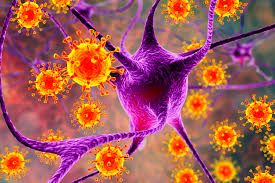
Prevention steps:
Since EBV is transmitted through close contact with others, the best way to prevent infection is by doing the following:
- Avoid anyone you know who has mono.
- Don’t kiss if you feel ill.
- If you have penetrative sexual intercourse, use a condomto avoid transmission through semen.
- Don’t share utensils and other items such as cups and glasses, hygiene products, or cosmetics.
- Avoid sharing cigarettes.
- If you care for young children, wash toys that they may have put in their mouths.
Boosting your immune system by eating a healthy diet and getting regular exercise and enough sleep is a good way to prevent not just mono, but any infection.
Good hand washing practices are also important and can reduce your risk of infection if you are exposed to the virus.3 Make sure to use antibacterial soap and wash your hands for at least 20 seconds. If you use hand sanitizer, choose one with at least a 60% alcohol content
Authors
-
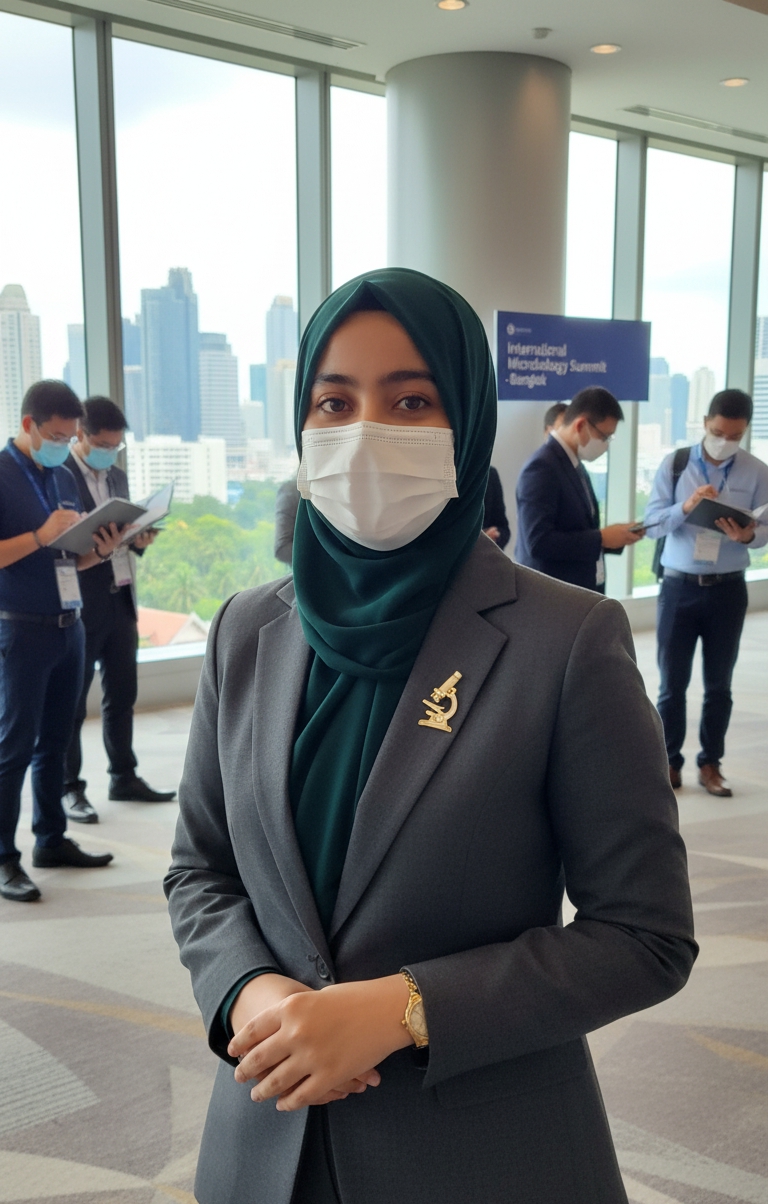
Qurat-ul-Ain is a multifaceted leader, Microbiologist, and CEO of Q Art Studio, blending science and art to drive social change.
-
Leadership: National Youth Leader (IIPL) and Ambassador for the International Diplomat Conference 2025.
-
Science & Literature: Researcher with 15+ articles, Medical Book Editor, and published poet/author.
-
Key Engagements: Speaker at ANSO-PAS, AASA-PAS, and NEXUS Summit LUMS on climate and leadership.
-
Awards: Recipient of the Peace Ambassador Award (Azerbaijan), SDGs National Award, and 100 Young Influencers recognition.
-
Mission: A motivational speaker and counselor dedicated to empowering women, promoting education, and pursuing advanced microbial research.
-
-

I am Wajiha Tabassum.I am Microbiology student of 4 semester in university of veterinary and animal sciences sub campus jhang. I am member of character building society
View all posts -

I am saira sufyan. I am studying BS applied microbiology from university of veterinary and animal sciences lahore sub campus jhang. I am a quick learner, I have also obtained a certificate in health and climate and I am also working as an ambassador for science and technology. And I have worked on mononucleosis and I have tried my best to make new innovations in field of Microbiology.
View all posts

